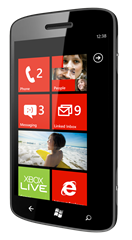Thanks for visiting my blog! See more about me here: About Me

A lot has been made since a report from Microsoft late last week (http://shawnw.me/HPEh0R) that seemed to say that Silverlight on the phone was going away in Windows Phone 8 (Apollo). I liked a lot of what this article had to say (from e-week):
So it got me thinking that much of the Silverlight community would be jumping out of windows (lower case and not TM) this week due to the news. But of course, if that’s the case for you, I’d urge you not to panic. Why? Let me tell you.
CAVEAT: I am guessing and have no inside knowledge on what Windows Phone 8 is going to do. Really!
Silverlight and Me
I came into Silverlight because of my prior work with WPF. But it’s more complicated than that. I came to WPF at a time when I was primarily known as a database guy (my old moniker was “The ADO Guy”). So why would I care about WPF? Data binding.
I am not a UI/UX guy. I can barely match my own socks. But I came to XAML because I saw the potential of building apps using a smart markup language that has the possibility of a real data binding framework (unlike MFC, VB5/6, WinForms, ASP.NET WebForms before it).
I got into Silverlight because I lucked into being there at the ground floor (I taught a WPF/E course at Microsoft to MS employees and partners before it was publically named). But even in the early days of XAML + JS, I saw the potential of building apps (not sites) with XAML. The fact that Silverlight was originally to build them in the browser was tangential. In fact, I liked Silverlight (v2 and beyond especially) because it learned from the lessons of WPF (which in my opinion is over engineered somewhat) and simplified the XAML so that it was consumable in a short period. The lack of features like Triggers and a simplified text stack meant that people could get up to speed fairly quickly.
Windows Phone 8 and XAML
What the Microsoft folks said was that Windows Phone 8 development would be much more like Windows 8 XAML development. That meant that Windows Phone 8 would probably have the underpinnings of WinRT. Should anyone panic? Nope. Here is why.
The WinRT XAML stack is based on Silverlight 4. What losing Silverlight does is say that the XAML (and data binding stacks) are going to be unmanaged. That’s a good thing. In Silverlight (especially on the phone) the managed part of the XAML stack (data binding et al.) got in the way of a great touch experience. In Mango, the Windows Phone team built several ways of keeping the experience smooth by doing a lot of tricks, but it is still pretty easy to screw it up as a developer. WinRT works differently. The entire XAML stack is in unmanaged code and the entire WinRT framework is built with async in mind. It makes it easier to build fluid, touch-enabled applications (or it should).
The other benefit is that it brings together the Metro-style application development on tablets and the phone. This is a big win for developers. This is likely not going to result in a single app working on both devices, but it should allow many of the assets to be more sharable. We have no details or promises yet, but if some of the features of WinRT come to the phone, we’re all in luck. I am especially looking forward to Contracts.
WinRT XAML Development
I’ve been digging into the Windows 8 XAML stack and as of the Consumer Preview I am really enjoying the experience. The Consumer Preview build is pretty close to Silverlight’s implementation IMO. There are likely some missing pieces, but all the big pieces are there. Adding to that, the great Visual Studio 11 XAML editing experience (powered by Blend) and I think you’ll find the development experience is really good right now.
If you’re a Windows Phone developer already, the experience of developing for Windows 8 (and Windows Phone 8 probably) will be pretty similar. App.xaml holds the application level events. Navigation to individual XAML files and support for a back-stack. Adding to the benefits here are things like Live storing of settings in the cloud (instead of inventing this yourself) as well as smoother touch APIs mean that the transition to WinRT should be smooth for Windows Phone developers.
If you’re a WPF or Silverlight developer, there are pieces to learn (like Navigation and touch) but the XAML design experience should very familiar. If you’re not digging into WinRT yet, it’s time to dip your toes into the water!
